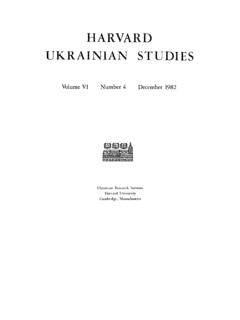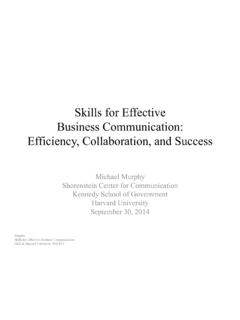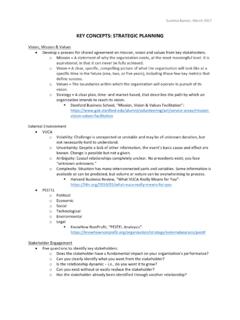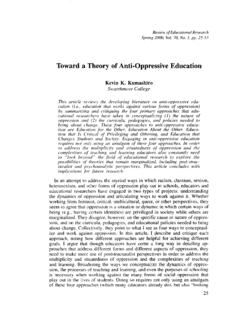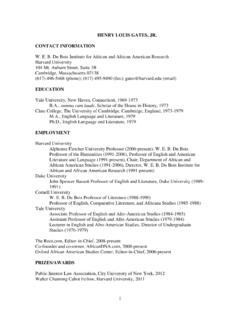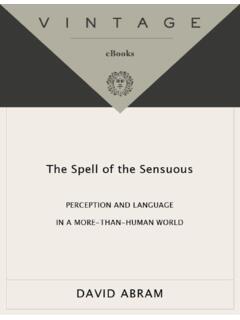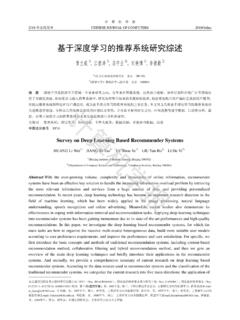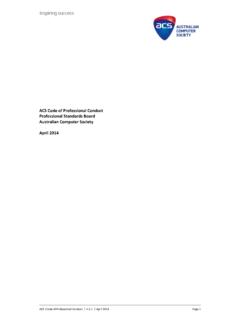Transcription of Solutions to Exercises Marked with from the book …
1 Solutions to Exercises Marked withs from the bookIntroduction to ProbabilitybyJoseph K. Blitzstein and Jessica Hwangc Chapman & Hall/CRC Press, 2014 Joseph K. Blitzstein and Jessica HwangDepartments of Statistics, Harvard University and Stanford UniversityChapter 1: Probability and (a) How many ways are there to split a dozen people into 3 teams, where one teamhas 2 people, and the other two teams have 5 people each?(b) How many ways are there to split a dozen people into 3 teams, where each team has4 people?Solution:(a) Pick any 2 of the 12 people to make the 2 person team, and then any 5 of theremaining 10 for the first team of 5, and then the remaining 5 are on the other team of5; this overcounts by a factor of 2 though, since there is no designated first team of5. So the number of possibilities is(122)(105)/2 = , politely ask the 12people to line up, and then let the first 2 be the team of 2, the next 5 be a team of 5,and then last 5 be a team of 5.
2 There are 12! ways for them to line up, but it does notmatter which order they line up inwithineach group, nor does the order of the 2 teamsof 5 matter, so the number of possibilities is12!2!5!5! 2= 8316.(b) By either of the approaches above, there are12!4!4!4!ways to divide the people into aTeam A, a Team B, and a Team C, if we care about which team is which (this is calledamultinomial coefficient). Since here it doesn t matter which team is which, this overcounts by a factor of 3!, so the number of possibilities is12!4!4!4!3!= (a) How many paths are there from the point (0,0) to the point (110,111) in theplane such that each step either consists of going one unit up or one unit to the right?(b) How many paths are there from (0,0) to (210,211), where each step consists of goingone unit up or one unit to the right, and the path has to go through (110,111)?
3 Solution:(a) Encode a path as a sequence ofU s andR s, , whereUandRstand for up and right respectively. The sequence must consist of 110R sand 111U s, and to determine the sequence we just need to specify where theR s arelocated. So there are(221110)possible paths.(b) There are(221110)paths to (110,111), as above. From there, we need 100R s and 100U s to get to (210,211), so by the multiplication rule the number of possible paths is(221110) (200100).Story Give a story proof that nk=0(nk)= : Consider picking a subset ofnpeople. There are(nk)choices with sizek, onthe one hand, and on the other hand there are 2nsubsets by the multiplication 1: Probability and Show that for all positive integersnandkwithn k,(nk)+(nk 1)=(n+ 1k),doing this in two ways: (a) algebraically and (b) with a story, giving an interpretationfor why both sides count the same for the story proof: Imaginen+ 1 people, with one of them pre-designated as president.
4 Solution:(a) For the algebraic proof, start with the definition of the binomial coefficients in theleft-hand side, and do some algebraic manipulation as follows:(nk)+(nk 1)=n!k!(n k)!+n!(k 1)!(n k+ 1)!=(n k+ 1)n! + (k)n!k!(n k+ 1)!=n!(n+ 1)k!(n k+ 1)!=(n+ 1k).(b) For the story proof, considern+ 1 people, with one of them pre-designated as president . The right-hand side is the number of ways to choosekout of thesen+ 1people, with order not mattering. The left-hand side counts the same thing in a differentway, by considering two cases: the president is or isn t in the chosen number of groups of sizekwhich include the president is(nk 1), since once we fixthe president as a member of the group, we only need to choose anotherk 1 membersout of the remainingnpeople. Similarly, there are(nk)groups of sizekthat don t includethe president. Thus, the two sides of the equation are (a) Show using a story proof that(kk)+(k+ 1k)+(k+ 2k)+ +(nk)=(n+ 1k+ 1),wherenandkare positive integers withn k.
5 This is called thehockey stick : Imagine arranging a group of people by age, and then think about the oldestperson in a chosen subgroup.(b) Suppose that a large pack of Haribo gummi bears can have anywhere between 30and 50 gummi bears. There are 5 delicious flavors: pineapple (clear), raspberry (red),orange (orange), strawberry (green, mysteriously), and lemon (yellow). There are 0 non-delicious flavors. How many possibilities are there for the composition of such a pack ofgummi bears? You can leave your answer in terms of a couple binomial coefficients, butnot a sum of lots of binomial :(a) Consider choosingk+ 1 people out of a group ofn+ 1 people. Call the oldest personin the subgroup Aemon. If Aemon is also the oldest person in the full group, thenthere are(nk)choices for the rest of the subgroup. If Aemon is the second oldest in thefull group, then there are(n 1k)choices since the oldest person in the full group can t beChapter 1: Probability and counting3chosen.
6 In general, if there arejpeople in the full group who are younger than Aemon,then there are(jk)possible choices for the rest of the subgroup. Thus,n j=k(jk)=(n+ 1k+ 1).(b) For a pack ofigummi bears, there are(5+i 1i)=(i+4i)=(i+44)possibilities sincethe situation is equivalent to getting a sample of sizeifrom then= 5 flavors (withreplacement, and with order not mattering). So the total number of possibilities is50 i=30(i+ 44)=54 j=34(j4).Applying the previous part, we can simplify this by writing54 j=34(j4)=54 j=4(j4) 33 j=4(j4)=(555) (345).(This works out to 3200505 possibilities!)Naive definition of A certain family has 6 children, consisting of 3 boys and 3 girls. Assuming that allbirth orders are equally likely, what is the probability that the 3 eldest children are the3 girls?Solution: Label the girls as 1,2,3 and the boys as 4,5, of the birth order is apermutation of 1,2,3,4,5,6, , we can interpret 314265 as meaning that child 3 wasborn first, then child 1, etc.
7 The number of possible permutations of the birth ordersis 6!. Now we need to count how many of these have all of 1,2,3 appear before all of4,5,6. This means that the sequence must be a permutation of 1,2,3 followed by apermutation of 4,5,6. So with all birth orders equally likely, we haveP(the 3 girls are the 3 eldest children) =(3!)26!= , we can use the fact that there are(63)ways to choose where the girlsappear in the birth order (without taking into account the ordering of the girls amongstthemselves). These are all equally likely. Of these possibilities, there is only 1 where the3 girls are the 3 eldest children. So again the probability is1(63)= A city with 6 districts has 6 robberies in a particular week. Assume the robberies arelocated randomly, with all possibilities for which robbery occurred where equally is the probability that some district had more than 1 robbery?
8 Solution: There are 66possible configurations for which robbery occurred where. Thereare 6! configurations where each district had exactly 1 of the 6, so the probability ofthe complement of the desired event is 6!/66. So the probability of some district havingmore than 1 robbery is1 6!/66 that this also says that if a fair die is rolled 6 times, there s over a 98% chancethat some value is repeated!4 Chapter 1: Probability and A college has 10 (non-overlapping) time slots for its courses, and blithely assignscourses to time slots randomly and independently. A student randomly chooses 3 of thecourses to enroll in. What is the probability that there is a conflict in the student sschedule?Solution: The probability of no conflict is10 9 8103= So the probability of there beingat least one scheduling conflict is For each part, decide whether the blank should be filled in with =,<,or>, and givea clear explanation.
9 (a) (probability that the total after rolling 4 fair dice is 21)(probability that thetotal after rolling 4 fair dice is 22)(b) (probability that a random 2-letter word is a palindrome1)(probability that arandom 3-letter word is a palindrome)Solution:(a)>. Allorderedoutcomes are equally likely here. So for example with two dice,obtaining a total of 9 is more likely than obtaining a total of 10 since there are two waysto get a 5 and a 4, and only one way to get two 5 s. To get a 21, the outcome mustbe a permutation of (6,6,6,3) (4 possibilities), (6,5,5,5) (4 possibilities), or (6,6,5,4)(4!/2 = 12 possibilities). To get a 22, the outcome must be a permutation of (6,6,6,4)(4 possibilities), or (6,6,5,5) (4!/22= 6 possibilities). So getting a 21 is more likely; infact, it is exactly twice as likely as getting a 22.(b)=. The probabilities are equal, since for both 2-letter and 3-letter words, being apalindrome means that the first and last letter are the Elk dwell in a certain forest.
10 There areNelk, of which a simple random sample ofsizenare captured and tagged ( simple random sample means that all(Nn)sets ofnelk are equally likely). The captured elk are returned to the population, and then a newsample is drawn, this time with sizem. This is an important method that is widely usedin ecology, known ascapture-recapture. What is the probability that exactlykof themelk in the new sample were previously tagged? (Assume that an elk that was capturedbefore doesn t become more or less likely to be captured again.)Solution: We can use the naive definition here since we re assuming all samples of sizemare equally likely. To have exactlykbe tagged elk, we need to choosekof thentaggedelk, and thenm kfrom theN nuntagged elk. So the probability is(nk) (N nm k)(Nm),forksuch that 0 k nand 0 m k N n, and the probability is 0 for allother values ofk(for example, ifk > nthe probability is 0 since then there aren t evenktagged elk in the entire population!)
